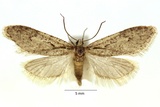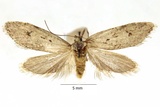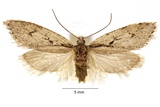Semioscopis avellanella (Hübner, 1793) Species
Last modified: June 8, 2025, 12:43 p.m.
A rare and local species in Belgium, more frequently observed in the southern part of the country.
Details
- Classification
- Family: Depressariidae > Subfamily: Depressariinae > Genus: Semioscopis > Species: Semioscopis avellanella
- Vernacular names
- Berkenplatlijf (NL)
- First mention in Belgium
- De Sélys-Longchamps E. 1844. Énumération des insectes Lépidoptères de la Belgique. — Mémoires de la Société royale des Sciences de Liége 2: 1–35. On page 23 (as Epigraphia avellanella H.). view page
- Status
-
Native
Distribution
Egg
Reddish orange, oval and flattened.
Caterpillar
Young larvae are white, head capsule black, prothoracic plate white. The full-grown larva is pale green with a darker green dorsal line, head capsule yellowish green, prothoracic plate green with some brown laterally.
Bionomics
The eggs are oviposited in small groups of up to eight eggs on the twigs of the larval host plant.
The larva constructs a silken tube made by rolling a leaf edge downwards. At night, it leaves this tube to chew holes in the nearby leaves. Larvae can be found from May till early September.
Pupation takes place within a cocoon amongst detritus on the ground.
This species hibernates in the pupal stage. Pupae can be found from September till early April.
Flight periods
One generation a year onwards from late February till April.
Observed on
- Host plant (species):
- Tilia cordata and Carpinus betulus
- Host plant (genera):
- Betula
The species prefers Betula spp. and Tilia cordata, but it has been found, though much less frequently, on Carpinus betulus.
Habitat
Mature Betula woodland, old forests with a lot of Tilia trees.



